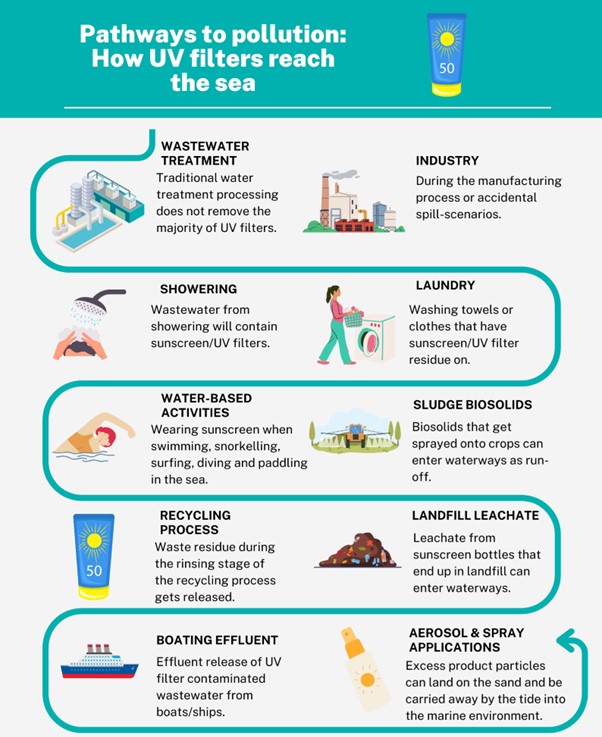SUNSCREENS: THE NEW EMERGING POLLUTANTS
In the UK, NHS (National Health Service) guidelines encourage us to apply 6–8 teaspoons of sunscreen every 2 hours, or immediately after a water-based activity, since at least 25 per cent of the product will wash off upon immersion. All sunscreens contain UV filters, which are added to either block or absorb the UV radiation from the sun. Chemical-based (organic) UV filters absorb incoming radiation, while mineral-based (inorganic) types that include titanium dioxide (TiO2) and zinc oxide (ZnO) reflect or scatter incoming radiation.
Predictably, organic UV filter- based sunscreens make up the bulk of products available in high street shops. Inorganic sunscreens sit directly on the epidermal layer of the skin, which can make them appear thick and pasty. To avoid the layered appearance of inorganic UV filters, manufacturers have begun to use nanoparticulate versions of these chemicals: for example, nano-titanium dioxide (nTiO2), which provide a more even and transparent application.
Within a given sunscreen formulation, there are between two and eight different UV filters to provide protection from as much of the UV spectrum as possible. An estimation in 2023 found that approximately 10 million tonnes of UV filters are produced annually for the global market, of which between 6,000 and14,000 tonnes are estimated to be released into coral reef zones alone annually. With coastal tourism and urbanization on the rise, these figures are expected to increase in coming years.
Pathways of UV filters
Organic UV filters are emerging and persistent pollutants, due to their widespread use and lack of biodegradability. UV filters can enter the marine environment directly or indirectly (Fig. 1). The direct pathways include the obvious wash-off from the skin into the sea and release from industry, either during the manufacturing process or in spill scenarios.

Figure 1. Pathways of UV filters derived from sunscreens into the marine environment.
Indirect pathways include wash-off residue from home showering, laundry washing (for example, from towels that have been used to dry sunscreen-coated skin), and sludge and wastewater application in agriculture. The latter is sourced from both biosolids (which can be contaminated with UV filters due to these pollutants being detected in both human urine and faeces) and domestic/industrial wastewater; farmers spread these onto their crops, and they subsequently enter waterways via run-off. Additionally, during the recycling process, used disposable bottles are washed and the residue released for water treatment. Most UV filters cannot be removed by current wastewater treatment technologies, resulting in the release of these compounds into the marine environment.
Effects of UV filters
Once these compounds enter the marine environment, what effect can they have on marine life? There is a lack of research into the ecotoxicological effects and environmental fate of UV filters in the marine environment. However, current research has largely focused on the effect of the organic UV filter oxybenzone on coral reefs. Exposure to organic UV filters has been linked to coral bleaching, with reports of complete bleaching and cell mortality in coral assemblages at environmentally relevant concentrations. Similar trends in mortality have been observed in fish, copepods, phytoplankton, and bivalves. Other effects include changes in jellyfish swimming patterns, reductions in reproductive potential, DNA damage, and oxidative stress in fish and bivalves (Fig. 2).

Figure 2. A summary of some of the biological and physiological effects of UV filters derived from sunscreens on marine organisms.
For inorganic UV filters, research has largely focused on echinoderms, where studies have concluded that nTiO2 and ZnO can cause DNA damage and a lack of motility and vitality in spermatozoa of the purple sea urchin. Oxidative stress and DNA damage have also been observed in bivalves, as well as a decline in photosynthetic rate in phytoplankton. However, some studies have found little or no effect of inorganic UV filters on marine organisms.
Transformation products
In the natural environment, when exposed to UV radiation, UV filters can undergo complete transformation via photodegradation. This means that a UV filter that started as one compound can transform into another under certain conditions. For example, octocrylene is an organic UV filter that can photodegrade into oxybenzone. This is a problem, because not only are the effects of transformation products unknown, but some are also being used in sunscreen formulations. Due to growing concerns over its effect on coral reefs, some sunscreen brands are moving away from oxybenzone to brand their product ‘reef-safe’. However, the alternative being used is often octocrylene, which photodegrades into oxybenzone. Oxybenzone has more than 20 degradation products alone. Inorganic UV filters, such as titanium dioxide, can degrade and act synergistically with hydrocarbons and pesticides in the marine environment – the impacts and long-term implications are as yet unknown.
What needs to be done?
More research is needed on the environmental fate and toxicity of compounds which are intended for use in the marine environment. Some UV filters, including oxybenzone, have been banned in Hawaii and other islands; however, regulations elsewhere are lacking. Research needs to focus on identifying compounds in sunscreen formulations that have damaging effects on the marine environment. This knowledge can then be translated into policy to ensure sunscreens are being manufactured with compounds that are not only effective at providing sun protection, but also safe for the marine environment.
- Anneliese Hodge (aho@pml.ac.uk), Plymouth Marine Laboratory and University of Plymouth
www.linkedin.com/in/anneliese-hodge-a164882b6
Blog: https://anneliesehodge03.wixsite.com/ themarinepost
Instagram: @themarinepost (or scan the QR code)
Further reading
Downs, C.A., Kramarsky-Winter, E., Segal, R., Fauth, J., Knutson, S., Bronstein, O., Ciner, F.R., Jeger, R., Litchtenfeld, Y., Woodley,
C.M., Pennington, P., Cadenas, K., Kushmaro, A. and Loya, Y. 2016. Toxicopathological effects of the sunscreen UV filter, oxybenzone (benzophenone-3), on coral planulae and cultured primary cells and its environmental contamination in Hawaii and the US Virgin Islands. Archives of Environmental Contamination and Toxicology, 70(2): 265-288. https:// doi.org/10.1007/s00244-015-0227-7
